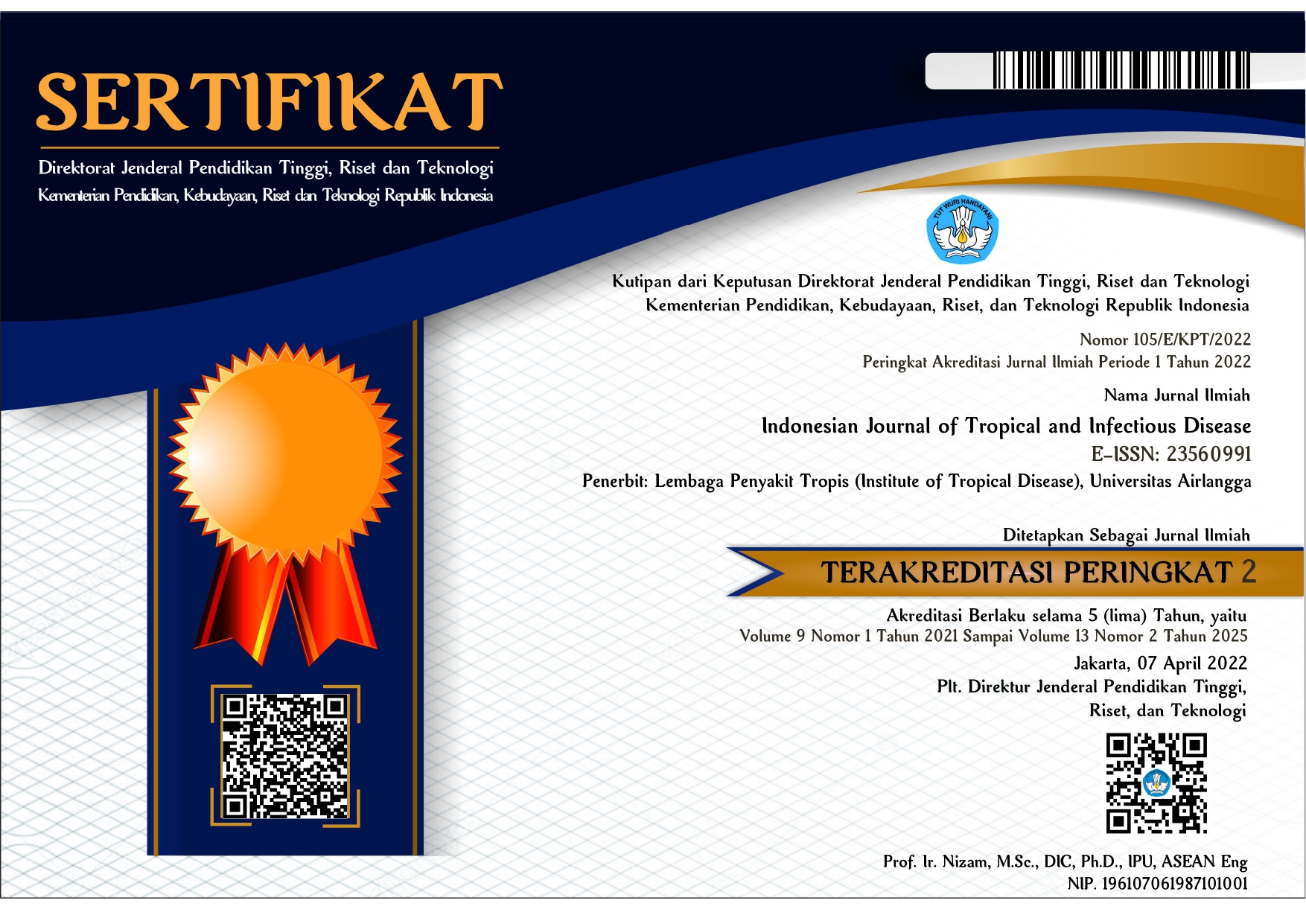Factors Analysis That Affecting The Treatment Success In Tb Patients In Situbondo Regency
Downloads
Tuberculosis (TB) remains one of the top 10 lethal infectious diseases). In addition, the low case detection rate indicates that the community still has a large number of sources of transmission. Directly Observed Treatment Short-course (DOTS) strategy aims to reduce the new TB cases number by 80% and deaths by up to 90% in 2030. Drug-resistant TB cases especially multidrug resistant TB, exacerbate tuberculosis control because they receive TB treatment irregularly and do not comply to recommended treatment schedules, nonetheless, consistent treatment is critical to successful TB treatment. TB data in Situbondo district show that case detection was 911 out of 1539 cases or 59.14% and treatment success rate was 275 out of 911 cases or 30.2%. This study aims to examine the influence of knowledge, medication supervisors, family support, drug side effects, attitudes, length of treatment, and house physical environment on the treatment success through medication compliance factors. This research is explanatory with 196 respondents while the analysis uses SMART PLS 4.1.0.3. There is a direct influence of medication supervisors, family support, drug side effects, house physical environment and medication compliance and an indirect influence of medication supervisors, family support, drug side effects, and attitudes to TB treatment success. It is hoped that Public Health Centre officers can be more active to educate, detect TB suspect, and also supervise patient so compliance and treatment can be achieved. The patient's family can be more active in providing support during the treatment period for TB sufferers.
Luqman, Sudaryo MK, Suprayogi A. Analisis Situasi Masalah Kesehatan Penyakit Menular di Provinsi Kalimantan Barat. J Epidemiol Kesehat Komunitas [Internet]. 2022;7(1):357–74. Available from: https://ejournal2.undip.ac.id/index.php/jekk/article/view/13269
Kementerian Kesehatan Republik Indonesia. Laporan Program Penanggulangan Tuberkulosis Tahun 2022 [Internet]. Jakarta; 2023. Available from: https://tbindonesia.or.id/pustaka_tbc/laporan-program-penanggulangan-tuberkulosis-tahun-2022/
World Health Organization. Global Tuberculosis Report 2023 [Internet]. Geneva; 2023. Available from: https://iris.who.int/.
Kementerian Kesehatan Republik Indonesia. Profil Kesehatan Indonesia Tahun 2022 [Internet]. Jakarta; 2023. Available from: https://p2p.kemkes.go.id/profil-kesehatan-2022/
Dinas Kesehatan Provinsi Jawa Timur. Profil Kesehatan Provinsi Jawa Timur Tahun 2022 [Internet]. Surabaya; 2023 Aug. Available from: https://dinkes.jatimprov.go.id/userfile/dokumen/PROFIL KESEHATAN JATIM 2022.pdf
Pameswari P, Halim A, Yustika L. Tingkat Kepatuhan Penggunaan Obat pada Pasien Tuberkulosis di Rumah Sakit Mayjen H. A. Thalib Kabupaten Kerinci. J Sains Farm dan Klin [Internet]. 2016 May;2(2):116–21. Available from: http://jsfk.ffarmasi.unand.ac.id/index.php/jsfk/article/view/60
Gunawan ARS, Simbolon RL, Fauzia D. Faktor-Faktor yang Mempengaruhi Tingkat Kepatuhan Pasien Terhadap Pengobatan Tuberkulosis Paru di Lima Puskesmas se-Kota Pekanbaru. J Online Mhs Fak Kedokt Riau [Internet]. 2017;4(2):1–20. Available from: https://jom.unri.ac.id/index.php/JOMFDOK/article/view/15495/0
Yadav RK, Kaphle HP, Yadav DK, Marahatta SB, Shah NP, Baral S, et al. Health Related Quality of Life and Associated Factors with Medication Adherence among Tuberculosis Patients in Selected Districts of Gandaki Province of Nepal. J Clin Tuberc Other Mycobact Dis [Internet]. 2021 May 1;23. Available from: https://pubmed.ncbi.nlm.nih.gov/33997309/
Seniantara IK, Theresia I, Gabrilinda AY. Pengaruh Efek Samping Obat (Obat Anti Tuberculosis) terhadap Kepatuhan Minum Obat pada Pasien TBC di Puskesmas. J Keperawatan Suaka Insa [Internet]. 2018;3(2):1–12. Available from: https://journal.stikessuakainsan.ac.id/index.php/jksi/article/view/98
Sutarto, Fauzi YS, Indriyani R, Sumekar RW DW, Wibowo A. Efikasi Diri pada Kepatuhan Minum Obat Anti Tuberkulosis (OAT). J Kesehat [Internet]. 2019;10(3):405–12. Available from: https://ejurnal.poltekkes-tjk.ac.id/index.php/JK/article/view/1479/1044
Pasaribu GF, Handini MC, Manurung J, Manurung K, Sembiring R, Siagian MT. Ketidakpatuhan minum obat pada pasien TB paru: Studi kualitatif. J Prima Med Sains [Internet]. 2023;5(1):48–56. Available from: https://jurnal.unprimdn.ac.id/index.php/JPMS/article/view/3788/2442
Islam F, Ahmad H, Nurbaya, Ahmad M, Ansar, Ramadhan K, et al. Factors Affecting Treatment Adherence among Patients with Tuberculosis in Indonesia: Literature Review. J Public Heal Pharm [Internet]. 2024;4(1):28–37. Available from: https://jurnal.unismuhpalu.ac.id/index.php/jphp/article/view/5022/3741
Lolong DB, Aryastami NK, Kusrini I, Tobing KL, Tarigan I, Isfandari S, et al. Nonadherence to Anti-Tuberculosis Treatment, Reasons and Associated Factors among Pulmonary Tuberculosis Patients in The Communities in Indonesia. PLoS One [Internet]. 2023;18(8 August):1–12. Available from: https://www.ncbi.nlm.nih.gov/pmc/articles/PMC10409295/
Ulfah M. Hubungan Dukungan Keluarga dengan Kepatuhan Minum Obat pada Pasien Tuberkulosis (TBC) di Wilayah Kerja Puskesmas Pamulang Kota Tangerang Selatan Tahun 2011. Universitas Islam Negeri Syarif Hidayatullah Jakarta; 2013.
Maulidya YN, Redjeki ES, Fanani E. Faktor yang Mempengaruhi Keberhasilan Pengobatan Tuberkulosis (TB) Paru pada Pasien Pasca Pengobatan di Puskesmas Dinoyo Kota Malang. Prev Indones J Public Heal [Internet]. 2017;2(1):44–57. Available from: https://journal2.um.ac.id/index.php/preventia/article/view/3191
Mokambu ZA, Yunus P, Syamsuddin F. Peran Pengawas Minum Obat (PMO) Terhadap Keberhasilan Pengobatan TB Paru Di Wilayah Kerja Puskesmas Bulango Ulu. J Inov Ris Ilmu Kesehat [Internet]. 2023;1(2):22–8. Available from: https://ejurnal.politeknikpratama.ac.id/index.php/Detector/article/view/1357
Siregar I, Siagian P, Effendy E. Dukungan Keluarga meningkatkan Kepatuhan Minum Obat pada Penderita Tuberkulosis Paru di Kabupaten Tapanuli Utara. J Kedokt Brawijaya [Internet]. 2019;30(4):309–12. Available from: http://jkb.ub.ac.id/index.php/jkb/article/view/2496
Risdayani, Bahar H, G FN. Analisis Kualitatif Peran Keluarga dalam Merawat Anggota Keluarga yang Menderita Penyakit Tuberkulosis Paru di Wilayah Kerja Puskesmas Poasia Kota Kendari Tahun 2016. J Ilm Mhs Kesehat Masy [Internet]. 2016;1(4):1–15. Available from: https://media.neliti.com/media/publications/185173-ID-analisis-kualitatif-peran-keluarga-dalam.pdf
Putri MH. Dukungan Keluarga sebagai Faktor Penting dalam Kepatuhan Minum Obat pada Pasien Tuberkulosis Paru. Wellness Heal Mag [Internet]. 2020;2(1):127–34. Available from: https://wellness.journalpress.id/wellness
Happi M, Dwi S, Santoso RP, Wijaya A, Prasetyo J. Hubungan Dukungan Keluarga Dengan Keberhasilan Pengobatan Tb Paru Di Poliklinik Paru Rsud Jombang. J Well Being [Internet]. 2021;6(2):26157519. Available from: http://journal.stikes-bu.ac.id/
Kurniawan N, Damanik SRH, Indriati G. Faktor-Faktor yang Mempengaruhi Keberhasilan Pengobatan Tuberkulosis Paru. J Online Mhs Bid Ilmu Keperawatan [Internet]. 2015;2(1):729–41. Available from: https://media.neliti.com/media/publications/188864-ID-faktor-faktor-yang-mempengaruhi-keberhas.pdf
Due A. What are Side Effects? Eur J Philos Sci [Internet]. 2023;13(1):1–21. Available from: https://philarchive.org/rec/DUEWAS
Ningsih ASW, Ramadhan AM, Rahmawati D. Kajian Literatur Pengobatan Tuberkulosis Paru dan Efek Samping Obat Antituberkulosis di Indonesia. Proceeding Mulawarman Pharm Conf [Internet]. 2022 May 31;15:231–41. Available from: https://prosiding.farmasi.unmul.ac.id/index.php/mpc/article/view/647
Amining F, Herawanto, Syahadat DS, Hasanah. Pengaruh Peran Pengawas Menelan Obat dan Efek Samping Obat Anti Tuberkulosis Terhadap Angka Kesembuhan (Cure Rate) Pasien Tuberkulosis. Prev J Kesehat Masy [Internet]. 2021;2(1):386–99. Available from: https://jurnal.fkm.untad.ac.id/index.php/preventif/article/view/451
Maghfiroh L, Irnawati. An Overview of Side Effects of OAT and Compliance with Taking Drugs in TB Patients. 16th Univ Res Colloqium Univ Muhammadiyah Pekajangan Pekalongan. 2022;47:498–505.
Rahajeng B, Shafira N, Utami P. Effects of Anti Tuberculosis Side Effect on the Quality of Life of Tuberculosis Patients in RSKP Respira Yogyakarta at the Period of January-June 2019. Proc 4th Int Conf Sustain Innov 2020–Health Sci Nurs (ICoSIHSN 2020) [Internet]. 2021;33:321–6. Available from: https://www.atlantis-press.com/article/125951249.pdf
Kementerian Kesehatan Republik Indonesia. Pedoman Nasional Pelayanan Kedokteran Tata Laksana Tuberkulosis. 2020.
Mientarini EI, Sudarmanto Y, Hasan M. Hubungan Pengetahuan dan Sikap terhadap Kepatuhan Minum Obat Pasien Tuberkulosis Paru Fase Lanjutan di Kecamatan Umbulsari Jember. J IKESMA [Internet]. 2018;14(1):11–8. Available from: https://jurnal.unej.ac.id/index.php/IKESMA/article/view/10401
Ali SM, Kandou GD, Kaunang WP. Faktor-Faktor yang Berhubungan dengan Kepatuhan Berobat Penderita TB Paru di Wilayah Kerja Puskesmas Siko Kota Ternate. Graha Med Nurs J [Internet]. 2019;2(1):72–81. Available from: https://journal.iktgm.ac.id/index.php/nursing/article/view/69
Kementerian Kesehatan Republik Indonesia. Peraturan Menteri Kesehatan Republik Indonesia Nomor 67 Tahun 2016 tentang Penanggulangan Tuberkulosis. Kementerian Kesehatan Republik Indonesia. Jakarta; 2016.
Nasution N, Arwina H, Nababan D, Silitonga E. Dorongan Motivasi Kesembuhan Penderita TB Paru di Wilayah Kerja Puskesmas Huristak Kabupaten Padang Lawas. J Ners [Internet]. 2023;7(2):993–1004. Available from: https://journal.universitaspahlawan.ac.id/index.php/ners/article/view/16896
Sahadewa S, Eufemia, Edwin, Luh N, Shita. Hubungan Tingkat Pencahayaan, Kelembaban Udara, dan Ventilasi Udara dengan Faktor Risiko Kejadian TB Paru BTA Positif di Desa Jatikalang Kecamatan Krian Kabupaten Sidoarjo. J Ilm Kedokt Wijaya Kusuma [Internet]. 2019;8(2):118–30. Available from: https://journal.uwks.ac.id/index.php/jikw/article/view/617
Sidiq N, Wahiduddin, Sidik D. Faktor Risiko Lingkungan Terhadap Kejadian Tuberkulosis Paru di Wilayah Kerja Puskesmas Somba Opu. J MKMI. 2013;29–35.
Mardianti R, Muslim C, Setyowati N. Hubungan Faktor Kesehatan Lingkungan Rumah Terhadap Kejadian Tuberkulosis Paru (Studi Kasus di Kecamatan Sukaraja Kabupaten Seluma). Nat J Penelit Pengelolaan Sumber Daya Alam dan Lingkung [Internet]. 2020;9(2):23–31. Available from: https://ejournal.unib.ac.id/index.php/naturalis/article/view/13502/0
Rismayanti EP, Romadhon YA, Faradisa N, Dewi LM. Hubungan Dukungan Keluarga dengan Tingkat Keberhasilan Pengobatan Pasien Tuberkulosis Paru. 13th Univ Res Colloqium [Internet]. 2021;191–7. Available from: https://repository.urecol.org/index.php/proceeding/article/view/1322
Meyrisca M, Susanti R, Nurmainah. Hubungan Kepatuhan Penggunaan Obat Anti Tuberkulosis dengan Keberhasilan Pengobatan Pasien Tuberkulosis di Puskesmas Sungai Betung Bengkayang. Lumbung Farm J Ilmu Kefarmasian [Internet]. 2022;3(2):277–82. Available from: https://journal.ummat.ac.id/index.php/farmasi/article/view/9049
Asrifuddin A. Analisis Capaian Keberhasilan Pengobatan TB Paru (Treatment Success Rate) Di Puskesmas Ranotana Weru Kota Manado. J Kesehat Masy [Internet]. 2018;7(1):69–76. Available from: https://ejournal.unsrat.ac.id/index.php/kesmas/article/view/22934
Wisesa W, Pebriyani U, Sudiadnyani NP, Lestari SMP. Hubungan Tingkat Pengetahuan tentang Penyakit Tuberkulosis dengan Kesembuhan Penderita Tuberkulosis Paru di Puskesmas Panjang Tahun 2021. Med Prof J Lampung [Internet]. 2021;11(4):383–90. Available from: https://www.journalofmedula.com/index.php/medula/article/download/497/651/4735
Fitria CN, Mutia A. Hubungan Tingkat Pengetahuan tentang Tuberkulosis dengan Kepatuhan Minum Obat di Puskesmas. J Ilmu Keperawatan dan Kebidanan [Internet]. 2016;7(1):41–5. Available from: https://ejr.umku.ac.id/index.php/jikk/article/view/125
Darsini, Fahrurrozi, Cahyono EA. Pengetahuan Artikel Review. J Keperawatan [Internet]. 2019;12(1):95–107. Available from: https://e-journal.lppmdianhusada.ac.id/index.php/jk/article/view/96
Sari ID, Mubasyiroh R, Supardi S. Hubungan Pengetahuan dan Sikap dengan Kepatuhan Berobat pada Pasien TB Paru yang Rawat Jalan di Jakarta Tahun 2014. Media Penelit dan Pengemb Kesehat [Internet]. 2016;26(4):243–8. Available from: https://media.neliti.com/media/publications-test/179255-hubungan-pengetahuan-dan-sikap-dengan-ke-c70b2fba.pdf
Rahmi N, Medison I, Suryadi I. Hubungan Tingkat Kepatuhan Penderita Tuberkulosis Paru dengan Perilaku Kesehatan, Efek Samping OAT dan Peran PMO pada Pengobatan Fase Intensif di Puskesmas Seberang Padang September 2012 - Januari 2013. J Kesehat Andalas [Internet]. 2017;6(2):345–50. Available from: https://jurnal.fk.unand.ac.id/index.php/jka/article/view/702/558
Asyrofi A, Setianingsih, Khakim M. Perbedaan Kepatuhan Minum Obat Pasien TB Paru dari Berbagai Dukungan Keluarga. Community Publ Nurs [Internet]. 2018;6(3):165–72. Available from: https://ojs.unud.ac.id/index.php/coping/article/download/53581/31754
Inayah S, Wahyono B. Penanggulangan Tuberkulosis Paru dengan Strategi DOTS. Higeia J Public Heal Res Dev [Internet]. 2019;3(2):223–33. Available from: https://journal.unnes.ac.id/sju/higeia/article/view/25499/13478
Nasedum IR, Simon M, Fitriani. Hubungan Dukungan Keluarga terhadap Kepatuhan Pengobatan Pasien Tuberkulosis Paru. Wind Heal J Kesehat [Internet]. 2021;4(4):358–63. Available from: http://jurnal.fkmumi.ac.id/index.php/woh/article/view/woh4408
Fitriani NE, Sinaga T, Syahran A. Hubungan antara Pengetahuan, Motivasi Pasien dan Dukungan Keluarga terhadap Kepatuhan Minum Obat Anti Tuberkulosis (OAT) pada Penderita Penyakit TB Paru BTA (+) di Puskesmas Pasundan Kota Samarinda. Kesmas Uwigama J Kesehat Masy [Internet]. 2019;5(2):124–34. Available from: http://dx.doi.org/10.24903/kujkm.v5i1.838
Perangin-angin N, Saragih J, Lismawati. Hubungan Dukungan Keluarga dengan Harga Diri Pasien TB Paru di Rumah Sakit Tentara Tingkat IV Pematang Siantar. J Ilmu Kesehat dan Gizi [Internet]. 2023;1(1):9–29. Available from: https://prin.or.id/index.php/jig/article/view/781/836
Maelani T, Cahyati WH. Karakteristik Penderita, Efek Samping Obat dan Putus Berobat Tuberkulosis Paru. Higeia J Public Heal Res Dev [Internet]. 2019;3(2):227–38. Available from: https://journal.unnes.ac.id/sju/index.php/higeia/article/view/31852
Aini L, Astuti L. Hubungan antara Efek Samping Obat Anti Tuberculosis (OAT) dan Peran Pengawas Menelan Obat (PMO) dengan Kepatuhan Pengobatan pada Penderita Tuberculosis (TB) Paru. Bablul Ilmi J Ilm Multi Sci Kesehat [Internet]. 2020;12(2):24–34. Available from: https://jurnal.stikes-aisyiyah-palembang.ac.id/index.php/Kep/article/view/935
Ardat. Pengaruh Pengetahuan dan Sikap terhadap Kepatuhan Minum Obat Pada Penderita TB Paru. J Pharm Heal Res [Internet]. 2020;1(2):49–53. Available from: https://journal.iktgm.ac.id/index.php/nursing/article/view/69
Dwiningrum R, Wulandari RY, Yunitasari E. Hubungan Pengetahuan dan Lama Pengobatan TB Paru dengan Kepatuhan Minum Obat pada Pasien TB Paru di Klinik Harum Melati. J Aisyah J Ilmu Kesehat [Internet]. 2021;6:209–14. Available from: https://aisyah.journalpress.id/index.php/jika/article/view/6S137
Panggayuh PL, Winarno M., Tama TD. Faktor yang Berhubungan dengan Keberhasilan Pengobatan Tuberkulosis Paru di Rumah Sakit Umum Karsa Husada Batu. Sport Sci Heal [Internet]. 2019;1(1):28–38. Available from: http://journal2.um.ac.id/index.php/jfik/index
Copyright (c) 2025 Indonesian Journal of Tropical and Infectious Disease

This work is licensed under a Creative Commons Attribution-NonCommercial-ShareAlike 4.0 International License.
The Indonesian Journal of Tropical and Infectious Disease (IJTID) is a scientific peer-reviewed journal freely available to be accessed, downloaded, and used for research. All articles published in the IJTID are licensed under the Creative Commons Attribution-NonCommercial-ShareAlike 4.0 International License, which is under the following terms:
Attribution ” You must give appropriate credit, link to the license, and indicate if changes were made. You may do so reasonably, but not in any way that suggests the licensor endorses you or your use.
NonCommercial ” You may not use the material for commercial purposes.
ShareAlike ” If you remix, transform, or build upon the material, you must distribute your contributions under the same license as the original.
No additional restrictions ” You may not apply legal terms or technological measures that legally restrict others from doing anything the license permits.























